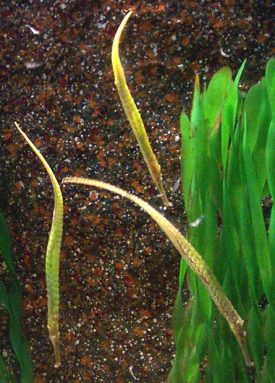Pipefish power from mom
When pop's a shrimp of a fish, mom passes on extra protein boost
Broad-nosed pipefish are curious little creatures. They’re close cousins of seahorses, which look like straws with eyes. Tiny and narrow, their slender bodies mean they can easily hide from predators. They do this by swimming into underwater grasses. Like seahorses, pipefish also reproduce in an unusual way: The female puts eggs into a pouch in the male. Dad then carries the embryos and gives birth.
In a recent study, researchers observed that when a female pipefish mated with a small-sized male, her eggs contained an extra amount of protein. The father also supplies some protein to his young. But if dad is small, the fertilized eggs he’s carrying contain additional protein — at least 10 percent more than in larger males, says Gry Sagebakken, who helped with the study. These proteins are like food: They help the embryos grow into full-fledged pipefish.
 |
|
In pipefish (shown), mom transfers her eggs to dad, who carries the embryos and gives birth.
|
| Siam Ocean World Aquarium in Bangkok, NSF |
Sagebakken is an ecologist at the University of Gothenburg in Sweden. Ecologists study how organisms and their environments influence each other. Previous studies had shown that large pipefish males produce large offspring. Sagebakken now suggests that the females add extra protein to the eggs to make up for what they don’t get from smaller dads.
Mating can be tricky for pipefish. Females compete fiercely with each other for the chance to deposit their eggs in the males. And it may take days for a female to successfully deposit eggs in the male. Once the eggs are in place, the female swims away — to start the cycle again and look for another male.
Inês Braga Gonçalves is another Gothenburg ecologist who worked on this study. Gonçalves, Sagebakken and their colleagues captured wild pipefish and gave each of 29 females two chances to mate: once with a large male and once with a smaller male. After a female had deposited her eggs into the male’s pouch, the researchers captured the male and examined the fertilized eggs. In smaller males, the eggs had more protein than did the eggs in the larger males.
Some scientists study mating choices. One goal for these scientists is to understand how those choices affect evolution. Evolution is the process by which organisms change over long periods of time. When an organism reproduces, its offspring will be slightly different from the parents. When those offspring mature and reproduce, their offspring too will be slightly different, and so on. Over time, these small changes can add to up to bigger changes. And those bigger changes might improve the species’ chance of survival.
So when the female gives extra protein to eggs deposited into smaller males, it could be that mom has evolved to do it. In other words, female broad-nosed pipefish have developed a way to improve their offspring’s chance of survival by giving them more food when dad is small. Since females compete for males, this extra protein could be a way to make up for the fact that not every female manages to mate with a large male.
For scientists who want to understand the role mate choices play in evolution, this study “is a nice example,” Elisabeth Bolund told Science News. It illustrates how complicated mate selection can be. Bolund is an evolutionary ecologist in Germany. She points out this study is a good first step. Still, she says, scientists need to do more experiments on the pipefish to fully understand the process of how they select mates.
POWER WORDS (adapted from Yahoo! Kids Dictionary)
ecology The science of the relationships between organisms and their environments.
environment The combination of external physical conditions that affect and influence the growth, development and survival of organisms.
biological evolution The process of physical change in living things across generations.
proteins Molecules that contain carbon, hydrogen, oxygen, nitrogen and usually sulfur and are composed of one or molecules called amino acids. Proteins are fundamental components of all living cells and include many substances that are necessary for the proper functioning of an organism.
reproduce To generate offspring by sexual or asexual means.







